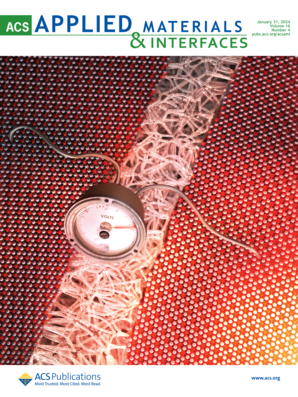(Bi0.5Na0.5)TiO3-NaNbO3-Bi(Mg1/2Zr1/2)O3 Lead-Free Relaxor Antiferroelectric Ceramics Featuring Ultrahigh Temperature-Insensitive Energy-Storage Performance.
IF 8.2
2区 材料科学
Q1 MATERIALS SCIENCE, MULTIDISCIPLINARY
引用次数: 0
Abstract
The development of lead-free dielectric ceramics with superior energy-storage performance is critical for next-generation pulsed-power capacitors. This work presents a breakthrough in lead-free (0.8-x)(Bi0.5Na0.5)TiO3-0.2NaNbO3-xBi(Mg1/2Zr1/2)O3 relaxor antiferroelectric ceramics featuring temperature-insensitive antipolar nanoregions with P4bm symmetry, as confirmed by ex- and in situ XRD, Raman spectroscopy, and TEM analysis. In-situ piezoresponse force microscopy demonstrates the electric-field-driven reversible transformation between the antipolar nanoregions and ferroelectric microdomains, accompanied by rapid recovery kinetics upon field removal. This behavior enables a linear-like polarization-field response with minimal hysteresis. Moreover, the synergistically improved grain morphology and band structure contribute to a significantly enhanced breakdown strength. As a result, a superb recoverable energy density Wrec ≈ 8.6 J/cm3 and a high energy efficiency η ≈ 85.5% are simultaneously achieved under 55 kV/mm in the x = 0.20 composition, which also exhibit a remarkable thermal stability (Wrec = 4.2 ± 1.7% J/cm3, η = 84.9 ± 4.0%, 20-260 °C) and ultrafast charge-discharge capabilities (Powder density PD = 264.7 MW/cm3, discharge energy density WD = 5.1 J/cm3, discharge time t0.9 < 30 ns). These findings demonstrate a promising strategy for exploiting lead-free dielectrics with desirable overall energy-storage features for capacitor applications.具有超高温不敏感储能性能的(Bi0.5Na0.5)TiO3-NaNbO3-Bi(Mg1/2Zr1/2)O3无铅弛豫反铁电陶瓷
开发具有优异储能性能的无铅介质陶瓷是下一代脉冲功率电容器的关键。该研究在无铅(0.8-x)(Bi0.5Na0.5)TiO3-0.2NaNbO3-xBi(m_1 / 2zr2 /2)O3弛豫反铁电陶瓷方面取得了突破性进展,具有P4bm对称的温度不敏感反极性纳米区,经原位和原位XRD,拉曼光谱和TEM分析证实。原位压响应力显微镜显示了电场驱动的反极性纳米区和铁电微畴之间的可逆转变,伴随着电场去除后的快速恢复动力学。这种行为使线性极化场响应具有最小的迟滞。此外,晶粒形态和能带结构的协同改善有助于显著提高击穿强度。结果表明,在x = 0.20的条件下,在55 kV/mm条件下,可回收能量密度Wrec≈8.6 J/cm3,高能量效率η≈85.5%,具有良好的热稳定性(Wrec = 4.2±1.7% J/cm3, η = 84.9±4.0%,20 ~ 260℃)和超快充放电能力(粉末密度PD = 264.7 MW/cm3,放电能量密度WD = 5.1 J/cm3,放电时间t0.9 < 30 ns)。这些发现为开发具有理想的整体储能特性的无铅电介质电容器应用展示了一个有希望的策略。
本文章由计算机程序翻译,如有差异,请以英文原文为准。
求助全文
约1分钟内获得全文
求助全文
来源期刊

ACS Applied Materials & Interfaces
工程技术-材料科学:综合
CiteScore
16.00
自引率
6.30%
发文量
4978
审稿时长
1.8 months
期刊介绍:
ACS Applied Materials & Interfaces is a leading interdisciplinary journal that brings together chemists, engineers, physicists, and biologists to explore the development and utilization of newly-discovered materials and interfacial processes for specific applications. Our journal has experienced remarkable growth since its establishment in 2009, both in terms of the number of articles published and the impact of the research showcased. We are proud to foster a truly global community, with the majority of published articles originating from outside the United States, reflecting the rapid growth of applied research worldwide.
 求助内容:
求助内容: 应助结果提醒方式:
应助结果提醒方式:


